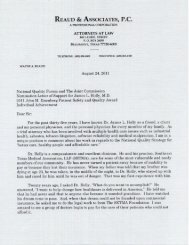Meaningful Use Case Study - himss
Meaningful Use Case Study - himss
Meaningful Use Case Study - himss
Create successful ePaper yourself
Turn your PDF publications into a flip-book with our unique Google optimized e-Paper software.
functionalities, which work in tandem with the EHR and practice management systemsto allow reporting, analysis, dashboarding and scorecards. COGNOS enables SETMA toidentify disparities and gaps in care, potential staff training/education needs andopportunities for care improvement.• Analyzing—SETMA analyzes performance audits to measure improvement by practice,clinic or provider—and to understand the meaning behind its processes and outcomesmeasures. Analysis focuses on any care discriminators—such as ethnic, age, gender,payer or treatment frequency disparities—to identify opportunities for careimprovement.• Reporting—SETMA publicly reports hundreds of quality measures on its Web site perprovider. The goal is to motivate improved performance by providers and increasedconfidence among patients, who are provided with documented plans of care to helpempower their own healthcare involvement. Reporting functions all are designed toovercome both provider and patient “treatment inertia.”• Improving—SETMA uses analysis tools to identify appropriate quality initiatives topursue. One current initiative, for instance, involves the elimination of all ethnicdiversities of care for diabetes, hypertension and dyslipidemia.ResultsSETMA meets national quality and best practice standardsThrough its EHR and BI data management tools, SETMA has eliminated any uncertainty aboutwhether it is meeting national quality standards—and its providers no longer need to waitmonths to receive quality reports from payers. COGNOS software allows every provider toexamine performance at the point-of-service on more than 200 quality metrics, including ageappropriatescreening and preventive care needs.The discrete data capture capabilities of SETMA’s EHR are used to measure, daily, eachindividual physician’s performance against “best practice” standards. Before a patient isseen, for example, his or her chart is searched to determine if standards have been met.Nurses independently initiate the completion of preventive and screening services accordingto age requirements.Dashboards enable interventions in response to seasonal patterns and population trendsSoftware also allowed SETMA to create dashboards that display seasonal outcomes patterns.For instance, trending showed diabetes patients were less healthy from October to Januarybecause of lax diet, exercise and medication interventions during the holiday season. Furtheranalysis revealed lower visit and testing frequency as well. As a result, the practice designeda plan to encourage checkups during the holidays. This issue never could have been noticed,or addressed, by looking at individual patient data.Dashboards allow the identification of population-wide trends that drive changes in practicepolicies that improve care. SETMA has been able to analyze patient populations by provider,practice, payer, ethnic group and socio-economic group. Some of the metrics reviewedinclude visit and test frequencies, number of medications taken, changes in treatments andpatient education levels.Disease management drives better high qualityIncorporating comprehensive disease management tools within EHR workflow also hasfurthered the ability of SETMA providers to deliver timely, quality care. Tools areavailable to help facilitate best practices in the diagnosis and treatment of diabetes,(continued)©2011 by the Healthcare Information and Management Systems Society (HIMSS)




